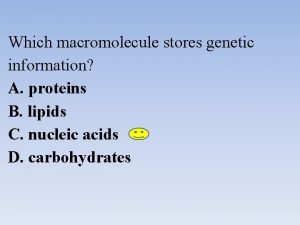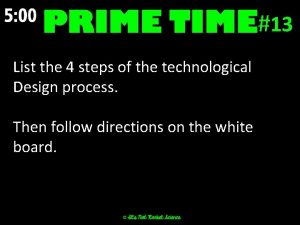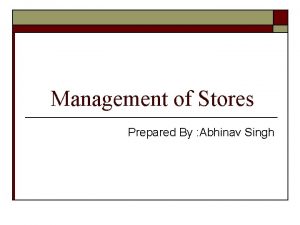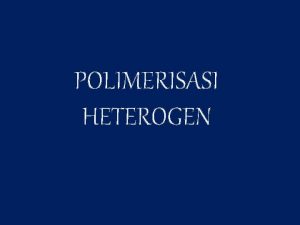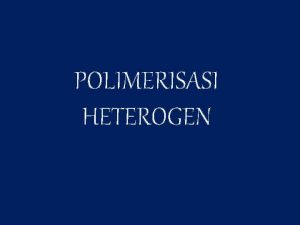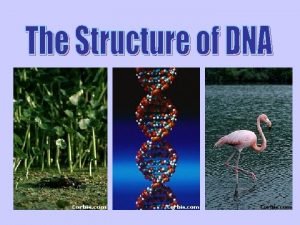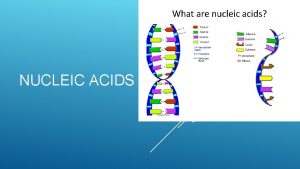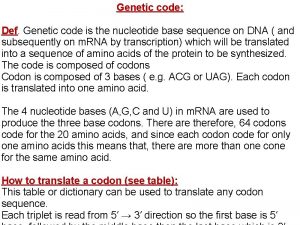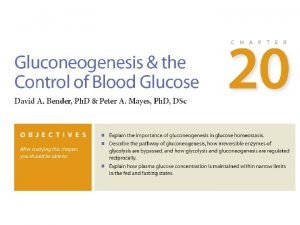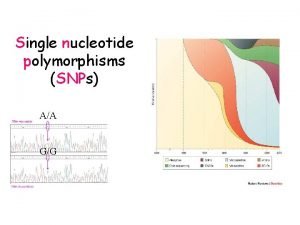Defined Molecule that stores genetic information Monomer Nucleotide












- Slides: 12


• Defined: Molecule that stores genetic information • Monomer: Nucleotide • Millions of nucleotides bond to make nucleic acids • Gene: section of DNA that holds instructions to build a protein

Nucleotide Structure • Three parts – Sugar molecule – Phosphate group – Nitrogen base (A, T, C, or G) • Nucleotides combine to make nucleic acids • A pairs with T • C pairs with G A T G C C A G T


• The nitrogen containing bases are the only difference in the four nucleotides • Nucleotides can be divided into 2 categories:

• Sugar (Deoxyribose) connects with the phosphate group • 4 Different Bases: – Adenine (A) – Thymine (T) – Guanine (G) – Cytosine (C) • Chargaff’s rules – Rule: A always joins with T – Rule: C always joins with G • Human DNA: ~3 billion pairs C T A A T G T

• James Watson and Francis Crick identified DNA’s structure in 1953 (see video clip: Structure of DNA) • Double Helix: spiral shape of DNA • Nucleotide strands are connected by a hydrogen bond

• Defined: Process of copying DNA – During interphase (S-stage) • Step 1: DNA Helicase “unzips” the two DNA strands (breaks the H bonds) • Step 2: Free floating nucleotides (A, T, C, G) match up • Step 3: DNA Polymerase reconnects the two strands

Step 1: DNA Helicase “unzips” the two DNA strands (breaks the H bonds) Step 2: Free floating nucleotides (A, T, C, G) match up Step 3: DNA Polymerase reconnects the two strands Both strands are identical Both strands are composed of a single strand of old and a single strand of new nucleotides. This is called the semi conservative model

DNA Replication Video Clip

enzyme • Mutation: change in DNA sequence • Mutations can be corrected – DNA Polymerase (enzyme) “proofreads” DNA and check/correct errors • Pre-repair: 1 in 10, 000 nucleotides has an error • Post-repair: 1 in 1 billion nucleotides has an error

1. 2. 3. 4. Re. View Name three parts of a DNA nucleotide. Name the four nitrogen bases and how they pair with others. Which nitrogen based are pyrimidines? Purines? List what takes place during the three stages of DNA replication. 5. Explain the semi-conservative model. 6. Fill in the missing DNA nucleotides: A C ? T ? ? ? G C T ? ? A ? C ? T T ? ? C ? T AT ? ? ? C A ? G ? ? 6. Where is the DNA mutation? TAGGCCTGTCGAACAGT ATCCGGACAACTTGT CA
 Which macromolecule fights disease
Which macromolecule fights disease Stores and transmits genetic (hereditary) information
Stores and transmits genetic (hereditary) information What macromolecule is used for contracting muscles? *
What macromolecule is used for contracting muscles? * Advantages of decentralized stores
Advantages of decentralized stores Genetic drift in small populations
Genetic drift in small populations Genetic programming vs genetic algorithm
Genetic programming vs genetic algorithm Genetic programming vs genetic algorithm
Genetic programming vs genetic algorithm Genetic drift
Genetic drift What is the difference between genetic drift and gene flow
What is the difference between genetic drift and gene flow Phân độ lown
Phân độ lown Block nhĩ thất độ 2 mobitz 1
Block nhĩ thất độ 2 mobitz 1 Thơ thất ngôn tứ tuyệt đường luật
Thơ thất ngôn tứ tuyệt đường luật Thơ thất ngôn tứ tuyệt đường luật
Thơ thất ngôn tứ tuyệt đường luật
